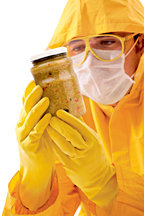Food Additives
What You Don't Know May Hurt You
By Christine H. Farlow, DC
Every day we are bombarded with ads on TV, radio and in magazines and newspapers trying to sell us the latest and greatest processed cuisine and "fake" foods. The ads promote great taste, low fat, added nutrients, attractive appearance and a host of other reasons to choose their product. There are even chemical concoctions marketed as better than real food, such as egg replacer products, nondairy dairy foods, fake meats and cheeses, and butter substitutes.
Are these products really good for you? You've undoubtedly heard it before, but it's worth repeating: To determine the healthfulness of any product on the market, you must first read the label. Note the information on the front of the package. That's what the manufacturer wants you to believe about the product. Manufacturers use terms like healthy and natural on the packaging even when the product is far from healthy or natural. These terms are undefined by the food industry; that means manufacturers can use them to mean anything they want.
The ingredients list is the most important area to read on every food package before you decide to purchase the product. Frequently, you'll have difficulty finding the ingredients list, and when you find it, you'll discover it's in a very tiny print and in a color that blends in with the packaging, making it very difficult to read. That's not just an accident. This is the information many food manufacturers don't want you to read. They make it difficult so only the most dedicated label readers will follow through and actually read what's in their product. The solution: Get a magnifying glass and carry it with you when you shop. Unless you're really good at reading the very tiny print, you'll probably need it.
 Why do you need to be a dedicated reader of the ingredients list? Because virtually all foods that are packaged in any way - in a bag, box, bottle, jar or can - contain food additives. Food additives are chemicals added to processed foods, most with little nutritional value, to make them look good, taste good, give them an appealing consistency or texture, and give them a long shelf life so they can sit on the grocery store shelf for a year (or more) and still taste fresh when you get around to eating them. Nearly all foods that have been through some form of processing contain food additives.
Why do you need to be a dedicated reader of the ingredients list? Because virtually all foods that are packaged in any way - in a bag, box, bottle, jar or can - contain food additives. Food additives are chemicals added to processed foods, most with little nutritional value, to make them look good, taste good, give them an appealing consistency or texture, and give them a long shelf life so they can sit on the grocery store shelf for a year (or more) and still taste fresh when you get around to eating them. Nearly all foods that have been through some form of processing contain food additives.
Preservatives are chemical additives used not only in foods to keep them fresh, but also in many nutritional supplements and over-the-counter (OTC) and prescription medications. These chemicals can cause a wide variety of adverse effects. Two particularly troublesome additives that are widely used are aspartame and MSG.
The Big Two: Aspartame and MSG
Aspartame, also known as Equal, NutraSweet or Spoonful, is an artificial sweetener used in many diet beverages, sugar-free foods, gum, candy, OTC medications, nutritional supplements and certain prescription drugs. Consumption of products containing aspartame has been associated with 92 different adverse reactions, from headaches, dizziness and difficulty breathing to memory loss, seizures and death. If a product label says the product contains phenylalanine or has a warning that phenylketonurics should not use it, the product most likely contains aspartame. (Phenylketonuria is an inherited metabolic disorder caused by an enzyme deficiency, resulting in the buildup of phenylalanine and its metabolites in the blood. This can lead to severe mental retardation and seizures unless phenylalanine is restricted from the diet, starting at birth.)

